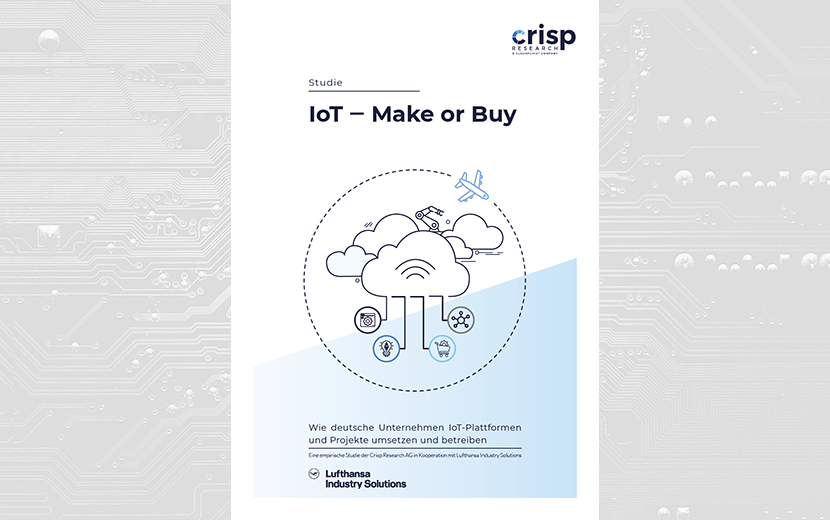Whether it’s Alexa reminding you of your next appointment or the refrigerator automatically filling your digital shopping cart, end users have long since become accustomed to the benefits of the Internet of Things. German companies can also benefit from this familiarity. But in the long term, connecting people, machines and software isn’t just about improving existing products – it’s about conquering entirely new fields of business.
The Crisp Research study “IoT – make or buy. How German companies are implementing and operating IoT platforms and projects”
The right strategy is key
To get there, companies need to set a radical course and answer questions such as “make or buy?”
When advancing IoT projects, companies are initially faced with a choice between using existing technologies or developing their own solutions – or whether a combination of both approaches is the right compromise. Each option has a range of advantages and disadvantages and offers different potentials for the future.
In this study, decision makers from a range of sectors were asked about their strategies for dealing with the Internet of Things. IoT projects are currently an issue of relevance for 90 percent of companies.
So the answer to the “make or buy” question – optimize or differentiate – is a decisive one when it comes to continued survival in a changing market.
The study contains
- opinions on IoT from decision makers,
- answers to the question “make or buy – which is the right strategy?”
- criteria for successfully implementing IoT projects and an overview of how IoT projects are implemented now and will be implemented in the future – from tailored solutions to third-party platforms,
- expert recommendations on future market orientation,
- insights into how companies finance their IoT projects, and
- condensed key findings in an executive summary.
Find vital answers to all your IoT-related questions in this study (only available in German).
The study was carried out by Crisp Research AG in cooperation with Lufthansa Industry Solutions, with 129 decision-makers from a wide range of sectors surveyed between May and June 2019.
You can read the results in the Crisp Research study 2019: “IoT – make or buy. How German companies are implementing and operating IoT platforms and projects.” You can download a PDF of the study for free (only available in German). We have summarized some of the most important findings for you here.
When “or” becomes “and”
For many businesses, the “make or buy” question is key to setting a course. Because this decision is so important, very few of them can state a clear position. Twenty-two percent of them believe they require the expertise of external technology providers. Only 4 percent agree with the statement that companies should take on the role of innovators themselves going forward. Most would prefer a combined approach and would like to turn the “or” into an “and.” As a result, they use existing technologies but customize and develop them to fit with their own requirements.
First comes optimization, then invention
A similarly cautions trend can be observed when it comes to implementing IoT projects. For most companies (69 percent), the first step is optimizing or further developing existing projects. Forty-nine percent said they developed new products as part of their IoT projects. Often, the focus is initially on known products and problem areas so that innovation becomes the second step of the process.
Optimization does not harbor the greatest potential
Although a certain degree of skepticism can be discerned among the decision makers concerning the implementation or further development of existing processes, they agree on where the most significant potential is to be found – according to 70 percent of respondents, it is in the development of new processes and products. This suggests that for many companies, the question of “make or buy?” could be displaced in favor of their own solutions and innovations.
IoT as an interdisciplinary subject
Implementing IoT projects requires not only the right strategy and associated expertise. As is often the case, it also requires appropriate investments. So where does the budget come from? Thirty-eight percent of respondents put IT departments as their top choice. That may not be very surprising. You could even regard this figure as bewilderingly low. That implies IoT could prove to be an interdisciplinary subject. Because business and the specialist departments are the ones who benefit most from the projects, this distribution of the financial burden makes sense and could, as recommended, even be expanded in future.
For detailed results on this and other questions, click here to download the Crisp Research study “IoT – make or buy. How German companies are implementing and operating IoT platforms and projects” (only available in German).






